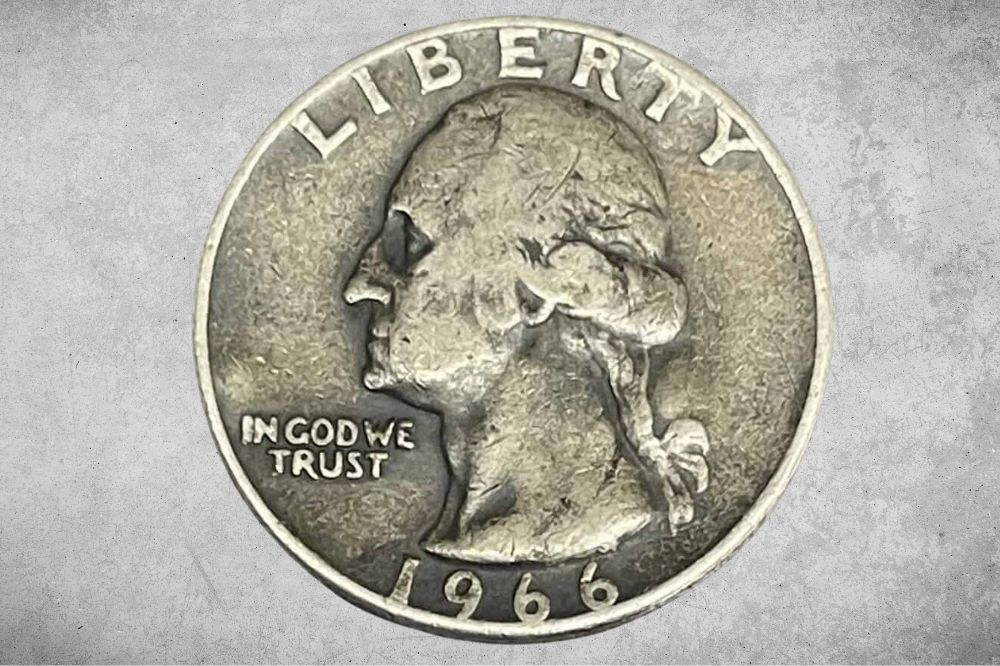The 1966 quarter features the design of beloved founding father George Washington, but the coin is valuable for reasons other than this. While most coins bearing this design are only worth $0.25, some 1966 quarters are worth a higher value.
A 1966 quarter in “Extremely Fine” or “Uncirculated” condition is often worth $2 to as much as $33, while Special Mint Strikes from this year sell for $50 or more. Coin condition plays the largest part in the value of the coin for collectors.
This guide explains the basic details of the coin, including the different varieties, how to grade the Washington quarter, and common errors from this time. Keep reading to learn more about what affects coin value.
1966 Quarter Details
- Category: Washington Quarter (1932 to 1998)
- Mint: Philadelphia; Denver; San Francisco
- Mintage: 823,301,500
- Obverse Designer: John Flanagan
- Reverse Designer: John Flanagan
- Composition: 90% Copper; 10% Nickel
- Weight: 0.2 oz
The 1966 quarter bears the John Flanagan Washington design we see in most coinage today.
The obverse features the profile of the first president facing the left of the coin. His long hair is pulled back with a ribbon into a low ponytail, and the designer initials “JF” are stamped at the base of Washington’s neck.
The coin reads LIBERTY above the top of Washington’s head and IN GOD WE TRUST tucked under his chin on the left. The year 1966 is stamped at the bottom curve.
On the back of the coin, we see an American Bald Eagle with its wings spread. The eagle faces the left, and it perches on a bunch of arrows above an olive branch.
The reverse reads UNITED STATES OF AMERICA across the top, E PLURIBUS UNUM between the country and the eagle’s head, and QUARTER DOLLAR along the bottom curve.
1966 Quarter Value Chart |
|||||
| Mint Mark | Good | Fine | Extremely Fine | Uncirculated | Special Mint Strike |
| 1966 No Mint Mark Quarter Value | $0.25 | $0.40 | $2 to $3 | $33.00+ | / |
| 1966 SMS Quarter Value | / | / | / | / | $50.00+ |
1966 Quarter Value and Varieties Guide
The 1966 quarter has a clad construction and all varieties lack mint marks. While Philadelphia, Denver, and San Francisco all minted coins this year, 1966 was engulfed by the Mint’s Anonymous Years.
These anonymous coins eliminate any desirable marks based on origin alone, and coins found in “Good” or “Fine” condition are rarely sold above face value. Collectors may snatch up a higher grade coin if needed, but they often hold out for the Special Mint Strike.
1966 No Mint Mark Quarter Value
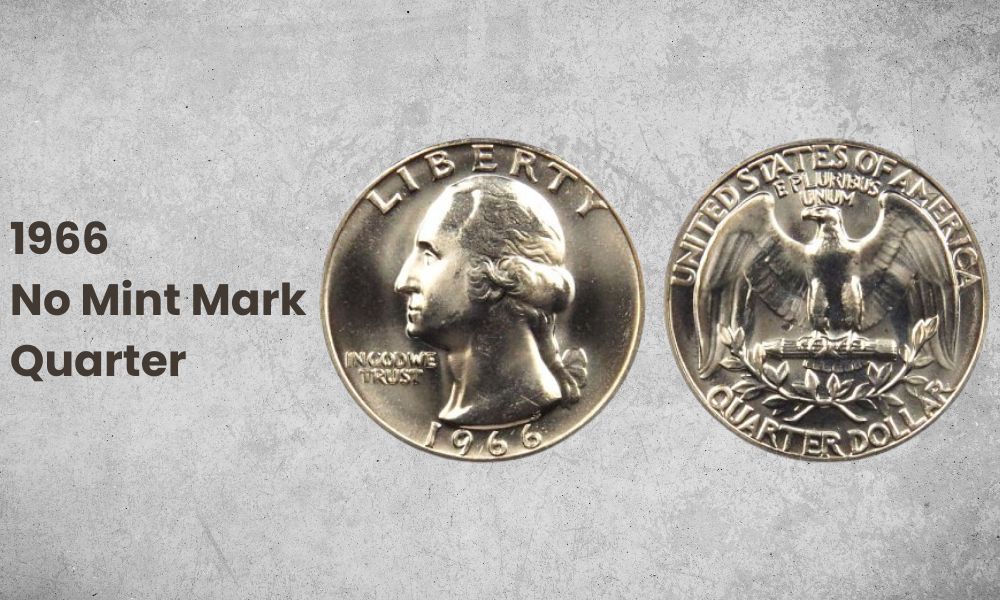
- Type: Washington Quarter (1932 to 1998)
- Edge: Reeded
- Mint Mark: N/A
- Place of Minting: Philadelphia; Denver; San Francisco
- Year of Minting: 1966
- Face Value: $0.25
- $ Price: $0.25 to $33+
- Quantity Produced: 821,101,500
- Designer: John Flanagan
- Mass: 5.67 g
- Diameter: 24.3 mm
Over 820 million 1966 quarters were put into circulation, and you’re still likely to find these coins in your pocket today. Because none of the mints marked the coin, there is little about the coins to attract collectors.
You may be able to sell one for $0.40 to $3.00 at a lower grade if you find a buyer who needs one, but even “Uncirculated” and Proof coins sell for a lower price. Collectors can snatch up a much more valuable coin for $30 or $50, rendering the more circulated coins useless for sentimental purposes.
This also means that many of these coins were cast into circulation without a care, and it may be difficult to find coins in Mint State. This leads to higher auction records, such as this PCGS MS-68 1966 quarter that sold for $11,750 in January 2019.
1966 SMS Quarter Value
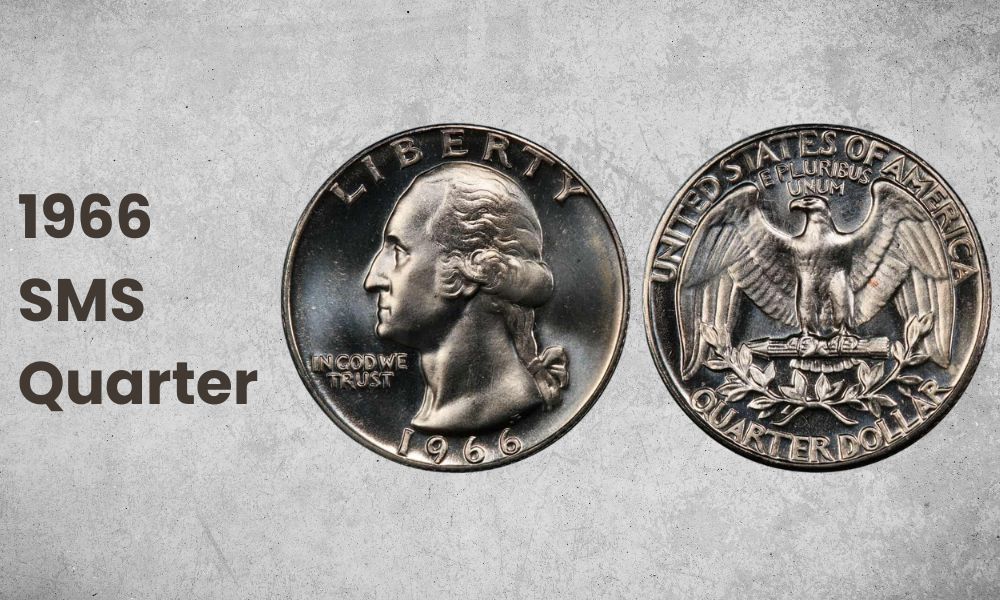
- Type: Washington Quarter (1932 to 1998)
- Edge: Reeded
- Mint Mark: N/A
- Place of Minting: San Francisco
- Year of Minting: 1966
- Face Value: $0.25
- $ Price: $50+
- Quantity Produced: 2,200,000
- Designer: John Flanagan
- Special Strike Composition: 75% Copper; 25% Nickel
- Mass: 5.67 g
- Diameter: 24.3 mm
There were no proof coins produced during these “Anonymous” years, but San Francisco did roll out some Special Mint Strike sets. The 1966 SMS quarters do not have a mint mark, and they originally sold for $4.
There are three varieties of 1966 SMS quarters to look for. A more run of the mill SP-68 sells for about $80, while 1966 Cameo quarters jump up to $210. The Deep Cameo variety has the fewest known, and a SP-68 DCAM 1966 quarts is estimated to sell for $6,500 if it went to auction today.
The current auction record for the 1966 SMS quarter is a PCGS SP-68 that sold for $4,112.50 in 2014.
1966 Quarter History
The 1966 quarter is part of the Washington Quarter series that ran from 1932 to 1998. While the design encompasses several important moments in history, the 1966 quarter is part of a small period of anonymous coinage from 1965 to 1967.
Silver prices had been on the rise, and they reached a peak in spring 1964. This led to the collection of these coins by the general public, as well as the normal collection of coins by numismatists at the time.
Coin collectors were blamed for the coin shortage (although a modern look back reveals the issue was more closely related to poor distribution), and Congress proposed legislation to offset this issue.
While the legislation to ban coin collecting altogether did not pass, Congress did order a freeze on 1964 coins until future notice. They also suspended proof coinage production and the use of mintmarks, resulting in anonymous coins during these years.
During this time, Congress also eliminated silver from the dime and the quarter to discourage hoarding of coins in future years. The error did not persist after these years of anonymity, but it has created a confusing period for those new to collecting.
Also Read: Top 15 Most Valuable Quarters In Circulation
1966 Quarter Grading
Grading a 1966 quarter can go one of two ways.
If you’re grading solely for hobbying purposes, you can assign a generic grade to reflect the condition of the coin. This type of grading is widely left up to interpretation, although we outline some guidelines below, and does not reflect a professional assessment of the coin.
If you’re selling, buying, or appraising your coin, you must pursue professional grading through PCGS or NGC. Your coin receives a grade on a 70 point scale, accompanied by any relevant information that verifies coin condition and any other premium features.
Good
A “Good” 1966 Washington quarter has a significant amount of wear. While both sides are relatively flat, the design should still show clearly.
The obverse is often weaker than the reverse, but letters are clear and separate from the edge. The rim on the edge should be intact, but most details are worn out.
Higher grades may show greater definition, but the overall condition of the coin reflects heavy circulation.
Fine
When a coin reaches a “Fine” grade most of the design elements are well exhibited. The rim is strong on both sides and separate from the rim, and details are evident in areas such as Washington’s hair and the feathers.
Wear is less evident, and the coin appears more clean than lesser grades. This is when you notice a difference between the effects on high and low relief areas.
Extremely Fine
An “Extremely Fine” 1966 quarter may retain its original mint luster, but it still bears wear from the years. The design is strong on both sides, and only high points have evidence of scratches or dulling from wear.
Details such as the hair and feathers are much more clear and defined. The more details available, the higher the coin’s grade likely is.
Uncirculated
An “Uncirculated” 1966 quarter has no wear and retains its original mint luster. Lower grades may have slight scratches from handling (such as bag marks), but nothing is large enough to distract from the coin’s original design.
Coins at this grade do not need to be perfect, but they’re incredibly close. They appear similar to coins produced this year, and most marks need a magnifying glass to detect.
Also Read: Top 16 Most Valuable Modern Quarters Worth Money
List of 1966 Quarter Errors
There are several 1966 quarter errors to look for, including:
- Wrong planchets
- Clipped planchets
- Double dies
- Strikethroughs
These are common issues in other coins and years, but they show up regularly in the 1966 quarter. You may also find less common mint errors on your coin, and all should be verified by a professional before assigning a premium value to the coin.
Watch out for “errors” that are actually derived from post-mint damage. Some issues, such as clipped planchets, are easy to mimic using tools. A professional coin grader will determine whether the marks are valid or not.
1966 Wrong Planchet Quarter
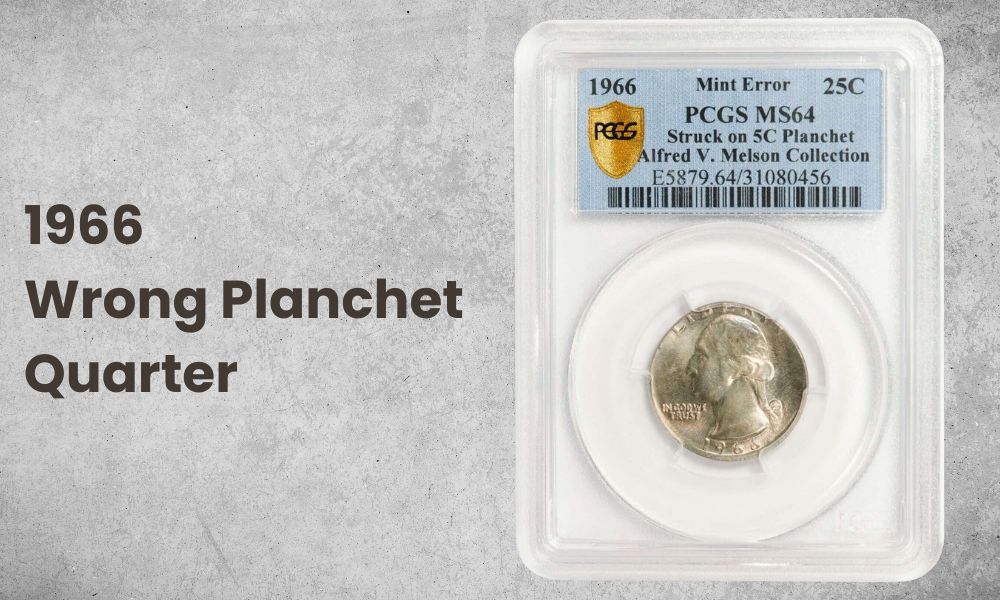
There are several example of a 1966 quarter struck on the wrong planchet, including:
- Five cent
- Cent
- Dime
When the coin is transposed on the wrong planchet, it usually has the same color and shape as the 1966 quarter but appears smaller (similar in size to the planchet it was struck on.
The 1966 quarter struck on a cent planchet may have redness in its color, and all varieties cut off lettering or numbers at the top or bottom. You must still be able to verify the year of the coin to score a premium value.
1966 Clipped Planchet Quarter
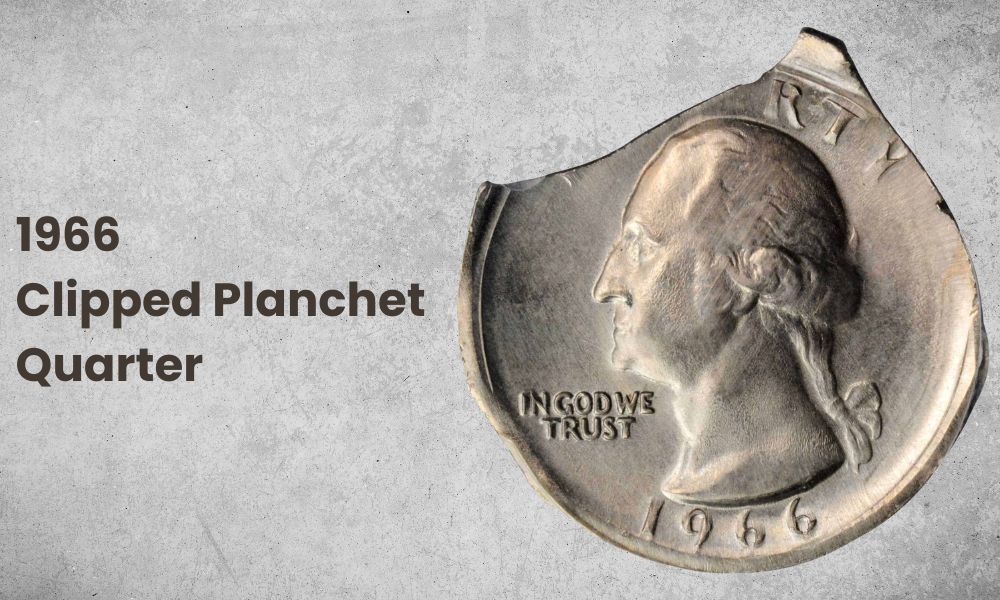
A clipped planchet occurs when the die strikes the edge of the coin, causing it to clip a portion of the coin off or curve the shape.
Nineteen sixty-six quarters with a clipped planchet regularly sell for $100 to $300 depending on the condition of the coin and the degree of the error. Like most errors, a greater deviation is usually worth more, but you need all identifying factors for the coin.
1966 Double Die Quarter
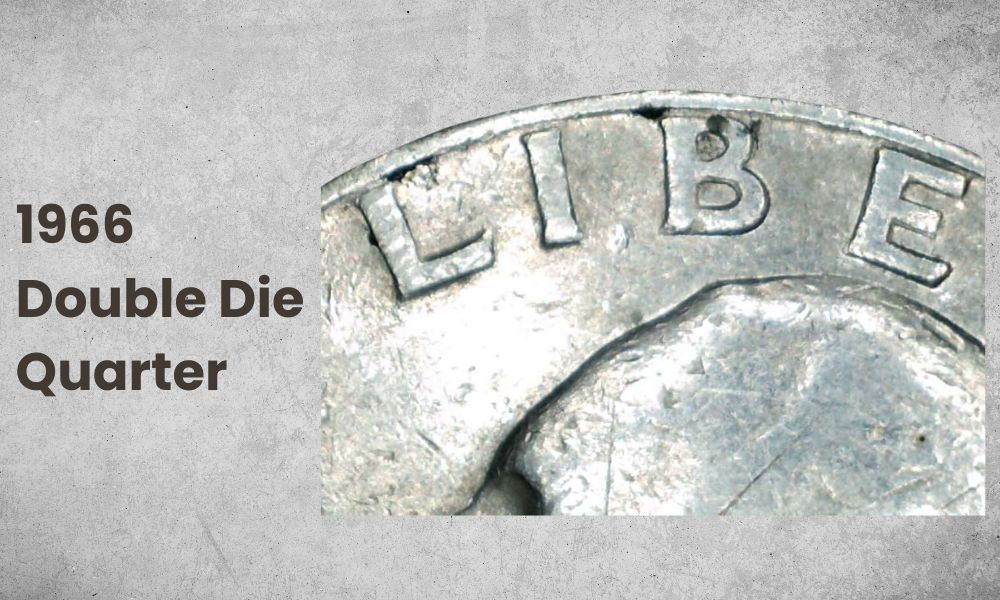
Double die quarters are those that were struck twice, although a coin may be struck three times or more as well. Doubling is just the most common form of this error.
When this happens, you see a ghost of the design on the 1966 quarter outside of the clear striking. This seems like a faint outline that doubles the original, and it can be difficult to discern with slight doubling.
1966 Strikethrough Quarter
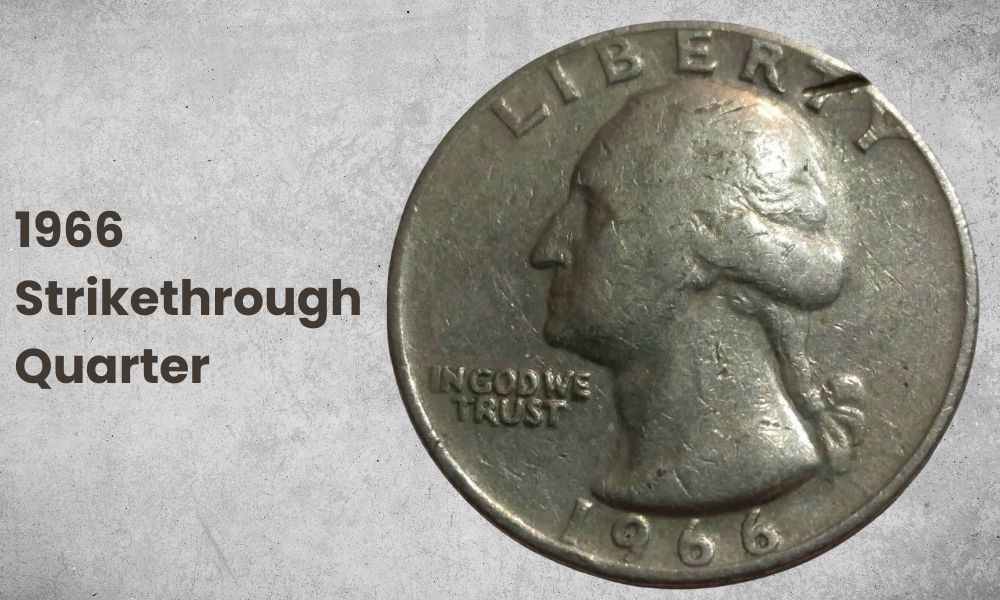
A struck through coin is one marked with a foreign object during the minting process. The mark usually isn’t large at all, and most struck through coins are the result of dust or other particles that stuck to the coin.
Larger examples have a higher value, especially those of high grade. Objects such as string or stray metal leave impressions on these coins. If you find a 1966 strikethrough quarter, you may pay $20 to $100 or more.
A Note on Potential 1966 Silver Error Quarters
The United States Mint switched the coin composition from 90 percent to 0 percent silver in 1965 to combat hoarding of the coins. While 1966 is a year off of this transition year, it’s rumored that silver error quarters exist.
While this claim has yet to be confirmed, there are confirmed silver error coins from 1965 and 1968, and it’s likely the years between have a few as well.
Silver quarters are shinier than the copper/nickel composition. They also have a bright silver shine on their edge, and you won’t see the layers of copper and nickel in this area.
Silver quarters have the same diameter and width, but they weigh slightly more . A standard 1966 quarter weighs 5.67 grams, while a silver quarter weighs 6.25 grams.
Also Read: 10+ Rarest State Quarter Errors Lists (Worth Much Money!!!)
1966 Quarter FAQs
How Much Is a 1966 Quarter Worth Today?
Most 1966 quarters are only worth their face value today, but those in collectible condition are worth $0.40 to $33 or more. The 1966 quarter produced for the Special Mint Set is worth about $50.
How Much Is a 1966 Quarter Worth with No Mint Mark?
The 1966 quarter with no mint mark is worth $0.25 to $33. All three mints produced anonymous coins this year, so there is no way to distinguish where the coin originated and derive a value from that detail. Value is instead tied to the condition of the coin, and only those in “Uncirculated” condition command a premium.
How Can You Tell If a 1966 Quarter Is Rare?
To tell if a 1966 quarter is rare, look for mint errors or inspect it for SMS condition. Coins from this year are not rare, but those that are better preserved or have a verifiable mint error will command a premium over their face value.
Is a 1966 Quarter Real Silver?
A 1966 quarter should not contain any silver; quarters from this year are composed of copper and nickel. Rumors suggest that accidental silver quarters may have been produced in 1966, but these are not confirmed.
